Imagine stepping into a living room that exudes calm, simplicity, and understated elegance — that’s the essence of Japandi style. Combining the best of Japanese minimalism and Scandinavian coziness, Japandi living rooms have become wildly popular for their serene beauty and functional design. This aesthetic not only creates a peaceful retreat but also promotes mindfulness and clarity in everyday life.
In this article, you’ll discover a variety of inspiring Japandi living room ideas that blend natural materials, neutral palettes, and sleek furnishings. Whether you’re aiming for a cozy nook or a spacious, airy feel, these ideas will guide you to craft a space that radiates tranquility and sophisticated charm. Get ready to transform your living area into a sanctuary of style and serenity!
1. Incorporate Low-Profile, Minimalist Furniture for a Spacious Feel
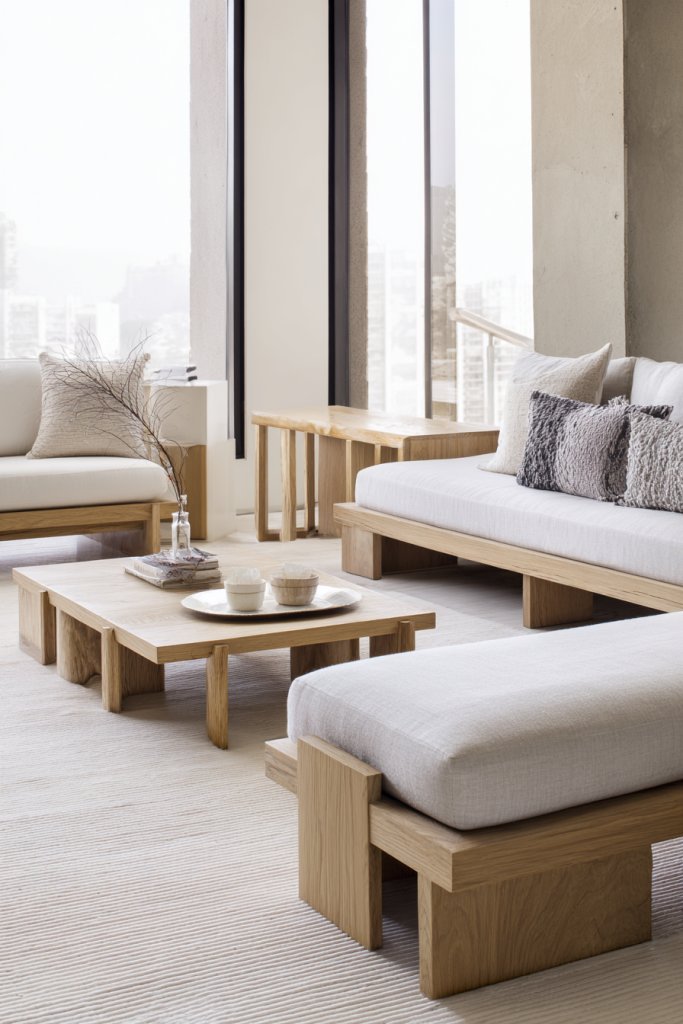
Feeling cramped in your living room? Sometimes, cluttered furniture makes even large spaces feel tiny. Opting for low-profile, minimalist pieces can instantly open up your room and create a breathable environment. It’s like giving your space room to breathe without sacrificing style.
Imagine sleek, low-slung sofas with clean lines paired with slim coffee tables that hover just above the floor. The furniture’s understated design makes the room appear larger, while the lack of bulky shapes keeps the eye moving freely. Light-colored upholstery and natural wood accents enhance the airy feel, making everything seem more expansive.
Choose furniture with slim legs or integrated storage to keep surfaces clutter-free. For small spaces, multi-functional pieces like foldable tables or wall-mounted units work wonders. In larger rooms, adding a few statement low-profile items can anchor the space without overwhelming it. Seasonally, you can swap plush cushions for lighter textiles to change the vibe.
Start by measuring your space carefully to select appropriately scaled furniture. Look for pieces with simple geometric shapes—think rectangles, squares, and cylinders—and avoid ornate details. Use modular furniture that can be reconfigured for different occasions or needs. Keep the color scheme light and neutral to maximize the sense of openness. When arranging, leave enough space around each item to prevent crowding.
Add personality with textured cushions, throws, or sculptural side tables that complement the minimalist aesthetic. Use subtle color accents or natural materials like stone or rattan for visual interest. Incorporate layered lighting—such as wall sconces or hidden LEDs—to emphasize the room’s spaciousness without cluttering surfaces. Personal touches like a favorite book or a decorative tray can make the space feel uniquely yours.
Minimalist furniture encourages a clutter-free mindset, which can boost your mental clarity. It also makes cleaning easier and quicker, saving you time and effort. When your space feels larger and more open, your mood improves, making your home a true haven of peace.
2. Use Natural Wood Elements for Warmth and Texture
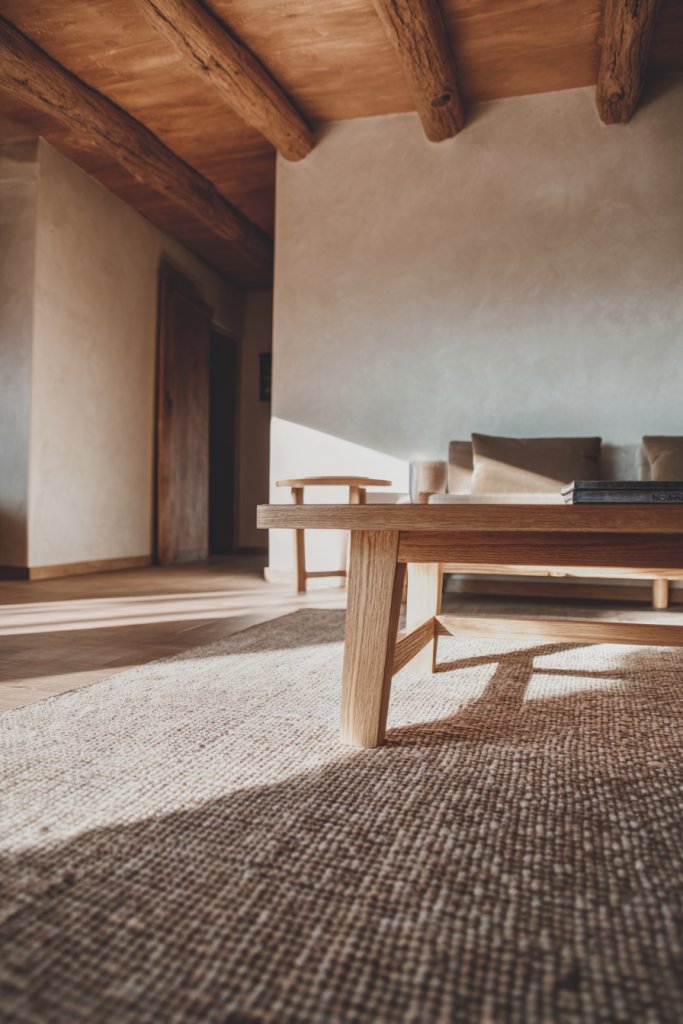
Do your rooms feel a bit cold or sterile? Natural wood adds warmth and texture that instantly make a space feel inviting. It’s a simple way to introduce organic charm without cluttering your decor. Plus, wood elements blend effortlessly with many color schemes, making your design more cohesive.
Visualize a living room with light oak flooring, a sleek coffee table, and floating shelves crafted from ash wood. The grain patterns add subtle visual interest, while the warm tones create a cozy ambiance. Soft lighting highlights the natural variations, accentuating the tactile appeal. The overall effect is an environment that feels grounded and calming.
Mix different wood finishes—like pairing darker walnut with lighter oak—to add depth. Incorporate wood in various forms: furniture, paneling, or decorative accents. For seasonal changes, you might swap out textiles and accessories to match the warmth of the wood. Larger spaces benefit from feature walls or statement furniture pieces, while smaller rooms can use wood accents sparingly.
Choose wood finishes that resonate with your style—smooth, matte, or textured. Use solid or engineered wood for durability. Incorporate wood in furniture frames, flooring, or wall paneling, depending on your skill level. Maintain the wood with occasional oiling or polishing to preserve its natural beauty. Combine with neutral paints or textiles for balance.
Create contrast by pairing warm wood with cool-toned textiles or metals. Add handcrafted wooden bowls, sculptures, or decorative panels to personalize your space. Use different grain patterns and finishes to keep the look layered and interesting. Incorporate handmade or vintage pieces to add character.
Natural wood elements connect your space to nature, boosting your mood and sense of well-being. They also stand the test of time, ensuring your decor remains stylish for years. When you incorporate organic textures, your home feels more alive and welcoming, making every day feel a little more peaceful.
3. Opt for Clean Lines and Simple Silhouettes in Decor Pieces

Ever feel overwhelmed by overly ornate or busy decor? Clean lines and simple silhouettes help create a calm, uncluttered environment that’s easy on the eyes. It’s about embracing minimalism to give your space a fresh, modern vibe. Less visual noise means more tranquility and clarity.
Imagine a sofa with sleek, rectangular arms and a low profile, paired with a slim, rectangular coffee table. The decor features geometric vases and smooth, rounded bowls—all in neutral shades. The overall aesthetic is effortlessly modern, with each piece contributing to a harmonious flow. Light plays softly across the surfaces, emphasizing their simplicity.
Choose furniture with straight, unadorned lines for a Scandinavian or modern look. For softer appeal, incorporate rounded edges or gentle curves. In small spaces, opt for multi-functional pieces with minimal hardware. Seasonal accents like textured cushions or throws can add warmth without disrupting the clean silhouette.
Focus on selecting decor with simple geometric shapes and smooth finishes. Use materials like matte metal, clear glass, or polished wood to keep the look cohesive. Organize your space with symmetrical arrangements to reinforce harmony. Avoid clutter by limiting accessories and focusing on essential pieces. When decorating, consider the visual weight of each object to maintain balance.
Add subtle textures through textiles like linen or cotton to soften the clean lines. Incorporate sculptural objects or handcrafted ceramics in neutral tones to add depth. Personalize with meaningful, minimalist art or functional decor that aligns with your lifestyle. Keep surfaces clear and organized to preserve the aesthetic.
Choosing decor with clean lines gives your space a timeless appeal that adapts to trends. It also simplifies cleaning and maintenance, making it easier to keep looking fresh. When your environment is uncluttered, your mind feels clearer and more focused, boosting your overall mood.
4. Add Textured Rugs in Subdued Tones to Anchor the Space
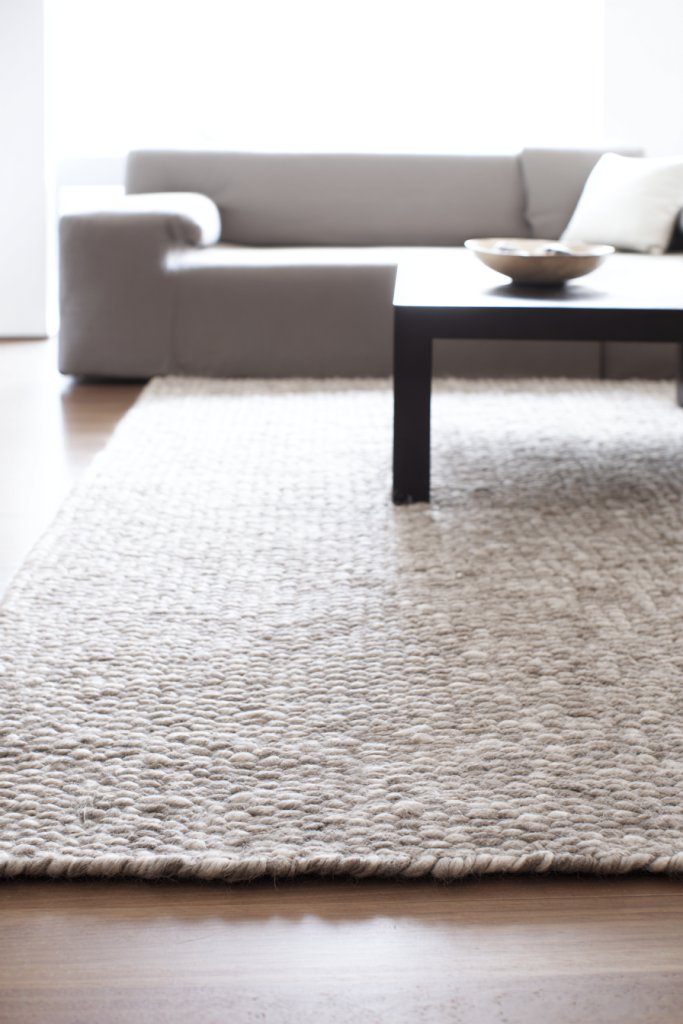
Do your floors feel flat or uninspired? Textured rugs in muted shades add depth and warmth without overpowering the room. They help define spaces and create visual interest, especially in open-plan layouts. Plus, they soften the floor, making your home more inviting.
Picture a jute or sisal rug with a woven texture laying beneath a low-profile sofa. The subtle pattern complements the neutral palette, adding tactile richness. The fibers’ natural look enhances the organic feel of the space, while the subdued tones keep the environment calm. The rug’s texture invites barefoot strolls and adds a cozy layer.
Choose rugs with different textures—braided, woven, or shaggy—depending on your style. For warmer seasons, lighter shades like beige or soft grey work well; in winter, darker, richer tones add coziness. Layering multiple rugs can add visual interest, or use a single large piece for simplicity. Smaller textured mats can define reading corners or entryways.
Select rugs made from natural fibers like jute, hemp, or wool for durability and eco-friendliness. Measure your space carefully to choose the right size—large enough to anchor the furniture set. Place the rug so that furniture legs rest comfortably on or just outside the edges. Regular vacuuming and spot cleaning keep textures looking fresh. If you’re feeling crafty, DIY woven rugs are also an option.
Coordinate your rug with other textiles—like cushions, throws, or curtains—in similar subdued tones. Add a few decorative objects in natural materials nearby to reinforce the organic theme. Layering different textures in your decor elevates the overall aesthetic. Don’t be afraid to mix patterns, as long as the palette remains consistent.
Textured rugs ground your space and create a welcoming environment. They’re versatile additions that adapt to various decor styles and seasons. When your floors are visually interesting, your entire room feels more cohesive and thoughtfully designed, encouraging you to relax and enjoy.
5. Maximize Natural Light with Sheer, Light-Filtering Curtains
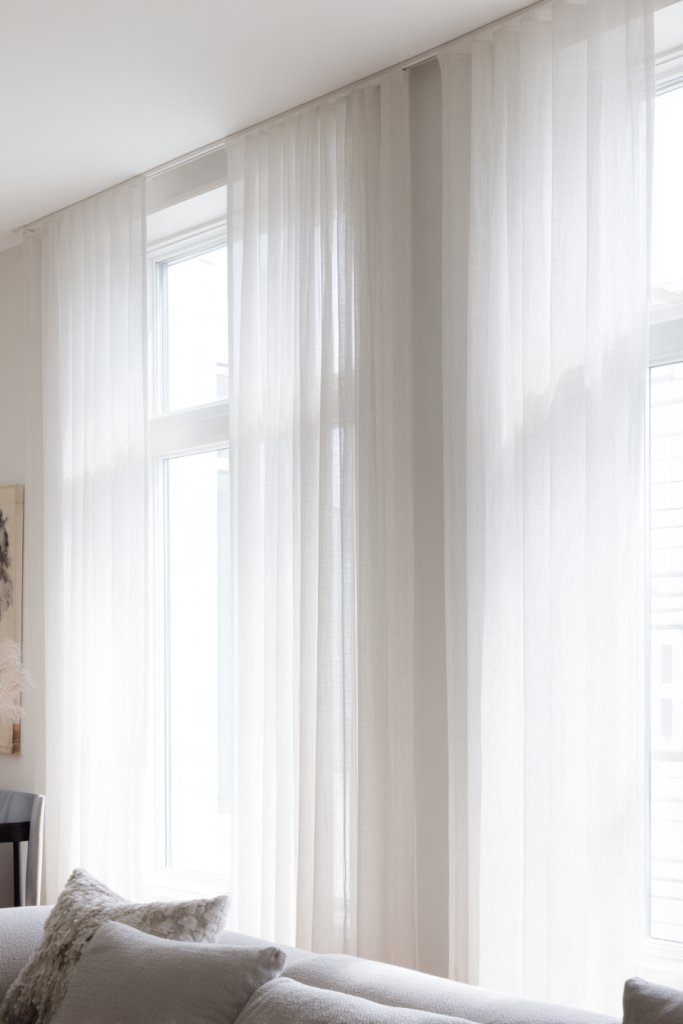
Feeling like your space is dark and gloomy? Natural light is key to creating an airy, uplifting environment. Sheer curtains in light fabrics let sunlight pour in while maintaining privacy. They soften harsh rays and add a gentle glow, making your living room feel larger and more inviting.
Visualize flowing, semi-transparent curtains in soft white or cream, billowing gently with a breeze. The light filters through, casting a warm, diffused glow across neutral walls and minimalist furniture. The fabric’s subtle texture adds a layer of softness, complementing the natural wood accents and textured rugs. The overall effect is a serene, luminous space that feels alive.
Opt for light fabrics like linen or voile for a breezy feel. For more privacy or a darker ambiance, layer sheer curtains with heavier drapes that can be drawn closed. Change the curtain length based on your window size—floor-length for grandeur, or just above the sill for a casual look. Incorporate tiebacks or decorative rods for added style.
Choose curtains in light, neutral tones to keep the space bright. Use simple, sleek rods that blend into the ceiling line to avoid visual clutter. Install hooks or brackets at the right height for a seamless look. Ensure the curtains are wide enough to cover the entire window and slightly overlap for privacy. Keep them clean and wrinkle-free with gentle washing and ironing.
Add subtle decorative touches like tassels or fabric trims to your curtains for a personal flair. Use tiebacks in natural fibers or simple metallic designs to hold curtains open and frame your view. Consider layering with blinds or shades for versatility. Play with different textures and colors within the same neutral palette for depth.
Maximizing natural light instantly boosts your mood and makes your home feel more spacious. It’s a simple, cost-effective way to refresh your decor and create an environment that’s both functional and beautiful. Bright, airy spaces inspire positivity and calm, transforming your everyday routines.
6. Select Monochromatic or Tonal Artwork in Neutral Shades
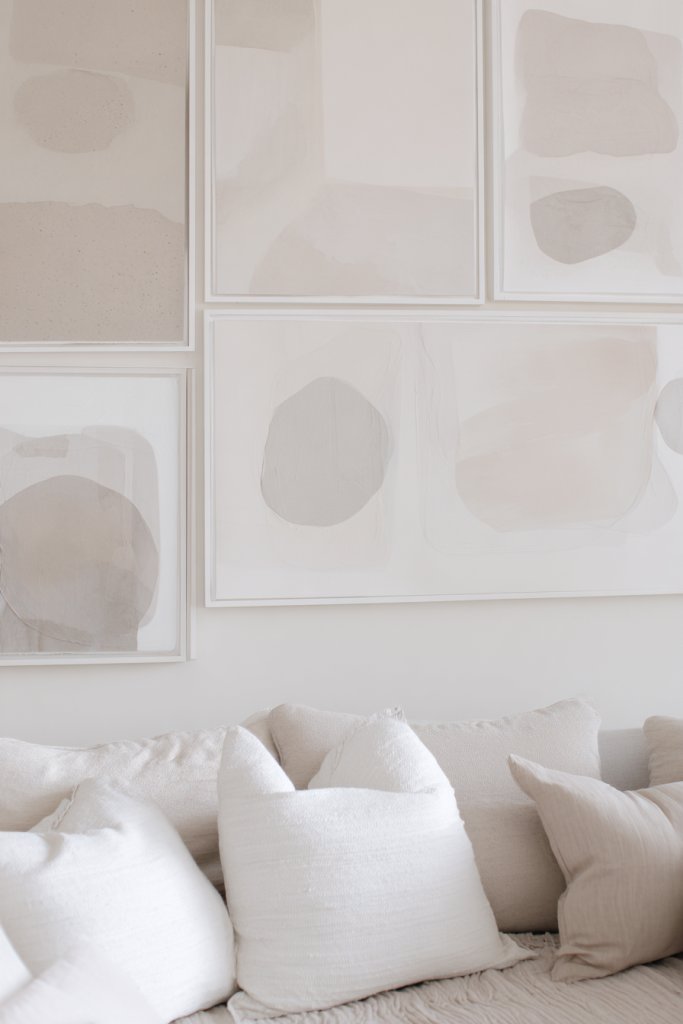
Worried about your walls feeling empty or plain? Choosing artwork in neutral tones helps add visual interest without disrupting the calm vibe. Monochromatic pieces create a cohesive look that’s sophisticated and understated. It’s the perfect way to bring personality into your minimalist space.
Imagine large-scale abstract prints in shades of soft greys, creams, or taupe hanging on your walls. The textures and subtle variations in color add depth, inviting closer inspection. The frames are sleek, perhaps in matte black or natural wood, emphasizing simplicity. These pieces complement your decor without overwhelming it, creating a balanced focal point.
Choose art with textured surfaces or embossed details for added dimension. For a more dynamic look, select a series of smaller, tonal pieces arranged in a grid or salon style. Change artwork seasonally—think soft prints in spring and more dramatic pieces in winter. Keep frames consistent for a uniform, polished appearance.
Opt for pieces that evoke calm, such as abstract or minimalist photography, in neutral shades. Use gallery rails or wire systems for easy swapping. Hang artwork at eye level for maximum impact, ensuring proper spacing. Maintain a simple framing style—thin matte borders or frameless options work well. Keep the walls clean and free of distractions.
Incorporate tactile elements like textured paper or canvas art for added richness. Personalize your space with handmade prints or custom pieces in neutral tones. Pair artwork with decorative textiles or sculptural objects for layered interest. The goal is harmony, not noise.
Tonal art in neutral shades elevates your decor with subtle sophistication. It’s easy to update or change without major redecoration, keeping your space fresh over time. When artwork blends seamlessly into your design, your room feels curated and calm, promoting relaxation.
7. Use Subtle Lighting with Recessed or Wall-Mounted Fixtures
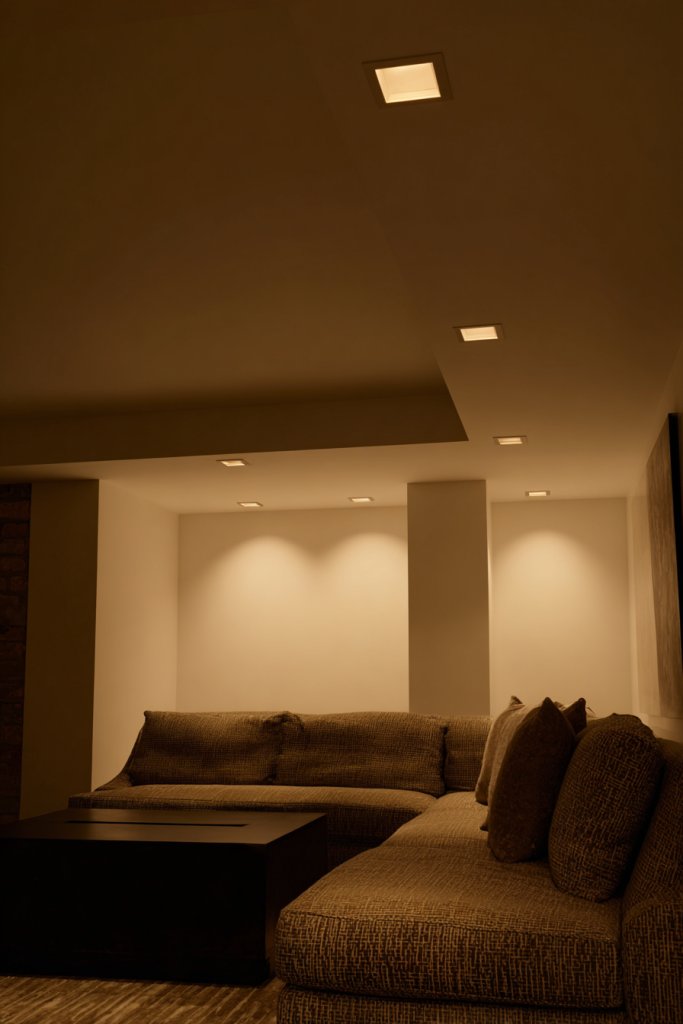
Harsh overhead lighting can ruin the serene vibe you’re after. Subtle, well-placed lighting creates a cozy ambiance that invites you to unwind. Recessed or wall-mounted fixtures eliminate clutter and keep the focus on your decor. It’s about creating a warm glow without the glare.
Picture LED recessed lights installed flush in the ceiling, casting soft pools of light across the room. Wall-mounted sconces in matte black or brushed bronze frame your space, adding both function and style. These fixtures provide layered lighting that highlights textures and architectural details. The result is an inviting, intimate environment.
Choose fixtures with dimming capabilities to adjust mood easily. For a minimalist look, select fixtures with simple, geometric shapes. Use accent lighting to highlight features like textured walls or architectural elements. In smaller rooms, keep fixtures close to the wall to maximize space. Seasonal lighting can include candles or portable lamps for variety.
Install fixtures at varying heights for layered lighting—over seating areas, near art, or along architectural features. Use warm white bulbs (around 2700K) to create a cozy atmosphere. Consider smart controls for easy adjustment. Avoid overly bright or cool-toned lights that clash with your serene aesthetic. Focus on creating a balanced, indirect glow.
Add decorative dimmer switches or smart lighting systems for convenience. Incorporate fixtures with artistic designs that complement your decor style. Use soft fabric or textured wall finishes to diffuse light further. Personalize your lighting plan to suit different activities—reading, relaxing, entertaining.
Layered, subtle lighting transforms your home into a calming oasis. It’s a simple yet effective way to elevate your decor and mood. When you control the ambiance easily, your living space becomes a true reflection of your personal retreat.
8. Introduce Soft Textiles in Natural Fibers for Comfort
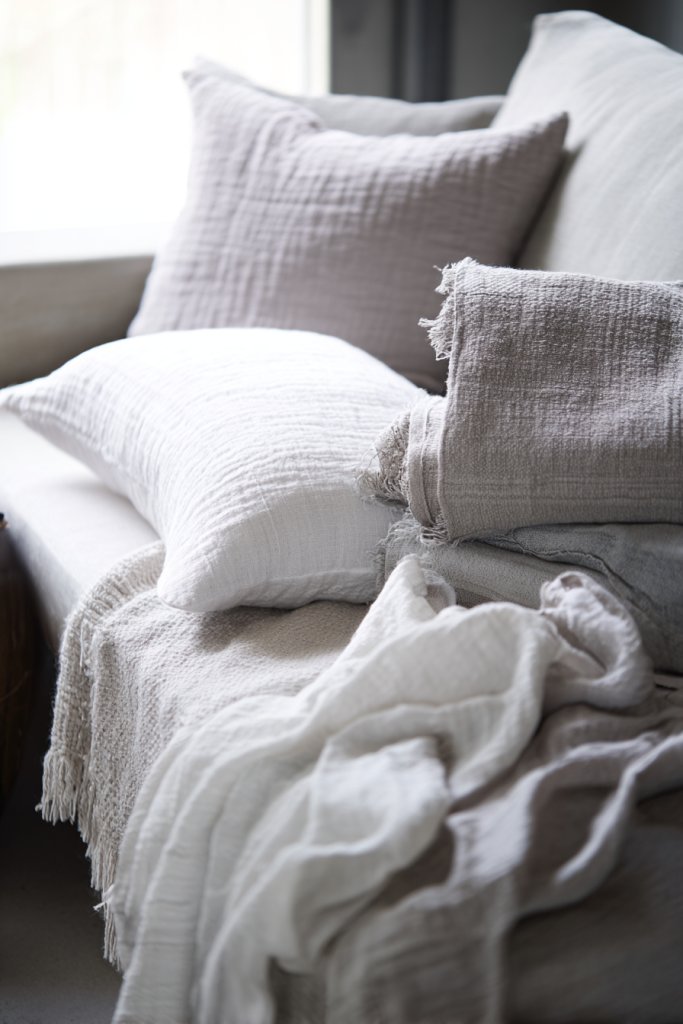
Does your living room feel a little too cold, even with all the decor in place? Soft textiles made from natural fibers add instant comfort and tactile warmth. They make your space more inviting and cozy, perfect for relaxing after a long day. Plus, they’re easy to swap out for seasonal updates.
Picture a plush linen cushion in a muted taupe resting on a sleek, low sofa. A hemp or cotton throw in a neutral tone drapes casually over the armrest. The textures invite touch, and the muted hues blend seamlessly with the surrounding decor. The overall effect is a calm, cozy environment that’s both functional and beautiful.
Mix different textiles—think linen, hemp, cotton, and wool—for a layered look that adds depth. Change textiles seasonally: lightweight linens for warmer months, thicker knits for winter. Use similar hues across cushions, throws, and upholstery for a unified aesthetic. Incorporate textured weaves and subtle patterns for visual interest.
Select high-quality natural fiber textiles that are durable and soft. Layer cushions and throws on your sofa and chairs—preferably in neutral or muted shades. Wash and care for textiles regularly to keep them fresh and inviting. For added dimension, incorporate different textures and weave patterns. Consider sewing your own covers or buying artisan-made pieces.
Personalize textiles with embroidered or handwoven details for a bespoke touch. Coordinate with other decor elements like textured rugs or ceramics. Use textiles to define seating areas or add visual interest to blank walls with fabric wall hangings. Keep a mix of textures and shades consistent with your overall palette.
Soft textiles in natural fibers amplify the cozy, organic feel of your space. They’re an easy way to add warmth and personality without clutter. When your environment feels comfortable and inviting, it encourages relaxation and a sense of well-being.
9. Incorporate Zen-Inspired Elements like a Small Indoor Fountain or Water Feature
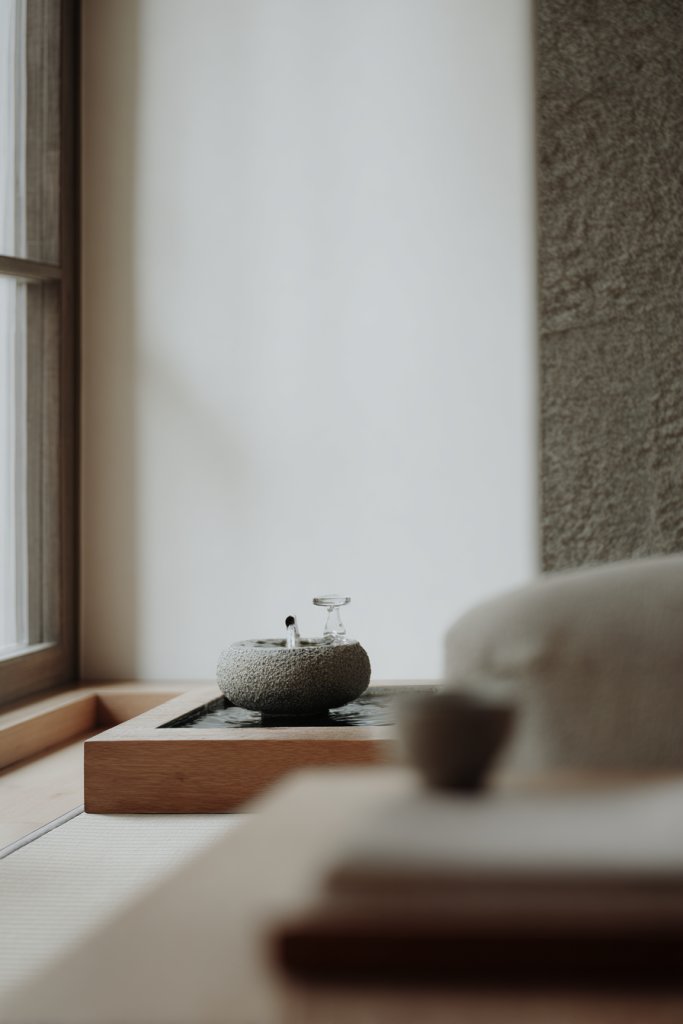
Looking for a way to cultivate peace and mindfulness at home? Zen-inspired elements like water features can transform your living room into a tranquil retreat. The gentle sound of flowing water helps drown out noise and calms your mind. It’s a subtle yet powerful way to enhance serenity.
Imagine a small, sleek basin with a quiet, continuous flow of water, placed on a natural wood or stone pedestal. The sound of trickling water creates a soothing ambiance, complemented by minimalist decor and natural textures. The feature adds a focal point that encourages mindfulness and a sense of harmony. Soft lighting accentuates the movement of water, adding to the calming effect.
Choose compact, self-contained water features that suit your space—think tabletop or small fountain units. Incorporate natural materials like stone, ceramic, or bamboo to keep the look organic. Position the water element near seating areas or entry points for maximum impact. Seasonal changes include adding floating candles or small stones for variety.
Pick a water feature that fits your space and budget. Place it on a sturdy, waterproof surface, ideally in a corner or against a wall. Use a quiet, energy-efficient pump to keep water flowing smoothly. Regularly clean and refill the basin to prevent algae buildup. Ensure electrical safety and proper drainage for the setup.
Add decorative stones, pebbles, or minimalistic sculptures around the fountain for a personalized touch. Incorporate subtle lighting—like LED strips or spotlights—to highlight the water movement at night. Use natural scents like essential oils nearby to enhance the sensory experience. Keep the environment clutter-free for maximum tranquility.
A water feature creates a calming ambiance that invites mindfulness and relaxation. It’s a beautiful way to connect with nature without leaving your home. When you incorporate Zen elements, your space becomes a sanctuary that supports your mental well-being.
10. Use Modular, Multi-Functional Furniture for Flexibility

Do you struggle with limited space and changing needs? Modular, multi-functional furniture offers flexibility that adapts to your lifestyle. Whether you need extra seating, storage, or a workspace, these pieces can transform your room effortlessly. They’re perfect for dynamic living environments.
Picture a sofa with removable sections that can be rearranged into a bed or a lounge. A coffee table that doubles as a storage unit or expands for entertaining guests. The furniture’s clean, simple design blends seamlessly with neutral walls and textured textiles. Its versatility makes your space feel larger and more functional.
Choose pieces with hidden storage compartments or adjustable components. For small apartments, opt for fold-away beds or wall-mounted desks that save space. Larger homes can incorporate sectional sofas with modular modules for different configurations. Use neutral finishes to keep the look cohesive across different setups.
Start by assessing your space and needs. Select modular pieces with durable, lightweight frames for easy rearrangement. Use multi-purpose furniture in key areas—living room, guest room, or office. Secure pieces properly to ensure safety and stability. Regularly maintain hinges and joints to keep everything functioning smoothly.
Personalize with textiles, such as removable covers or cushions, that match your decor palette. Incorporate decorative elements like textured throws or minimalist accessories. Use color and texture to distinguish different configurations or zones within your space. Keep the design simple to maintain the minimalist aesthetic.
Modular furniture empowers you to customize your environment as your needs evolve. It also encourages creative thinking about space utilization. When your home adapts to your lifestyle, it feels more comfortable and inspiring every day.
11. Highlight Architectural Details with Beamed Ceilings or Exposed Wooden Elements
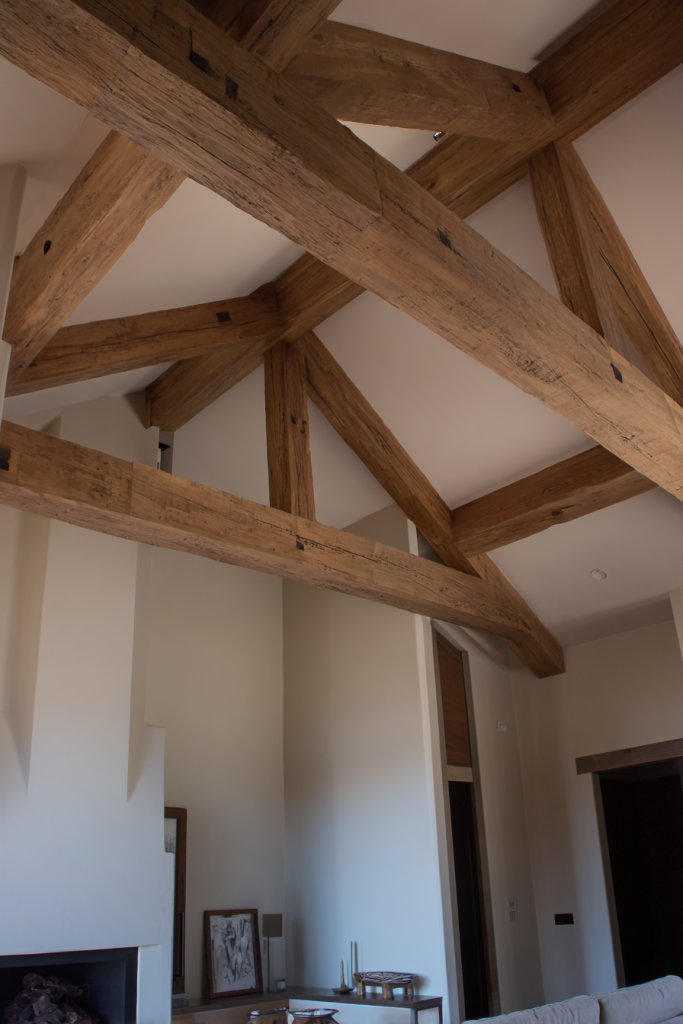
Want to add instant character to a plain room? Highlighting architectural details like beamed ceilings or exposed wood can dramatically elevate your space. These natural elements add warmth and texture without clutter. They bring a handcrafted, authentic feel that’s hard to replicate.
Imagine a ceiling with rustic wooden beams contrasting against crisp white walls. The beams draw your eye upward, creating a sense of height and space. Exposed wooden wall panels or framing details add depth and tactile interest. The natural grain and imperfections enhance the room’s organic vibe, making it feel cozy yet modern.
Choose beams in darker, weathered finishes for a rustic look or lighter, smooth wood for a minimalist aesthetic. Incorporate similar wood accents into furniture or trim to create a cohesive design. In smaller spaces, keep the exposed elements subtle to avoid overwhelming the room. Seasonally, you can enhance the look with textiles or decorative accessories.
Consult a structural engineer or contractor for ceiling beam installation, especially if adding heavy timber. Use reclaimed or sustainably sourced wood for an eco-friendly approach. Finish beams with natural oils or stains that match your decor. Exposed wood can be left raw or sealed for durability. Proper lighting can accentuate the architectural features effectively.
Complement with minimalist lighting fixtures like spotlights or sconces to highlight the wood details. Add subtle textural contrasts with plaster or stucco walls to enhance the organic feel. Incorporate furniture and accessories that echo the natural theme—think linen, rattan, or stone. Personal touches like handcrafted wooden decor deepen the authenticity.
Architectural details anchor your space and reflect craftsmanship and history. They create a warm, inviting atmosphere that feels unique and curated. When you highlight natural elements, your home becomes a testament to timeless design and personal style.
12. Maintain Open Space with Minimal Decor and Accessories
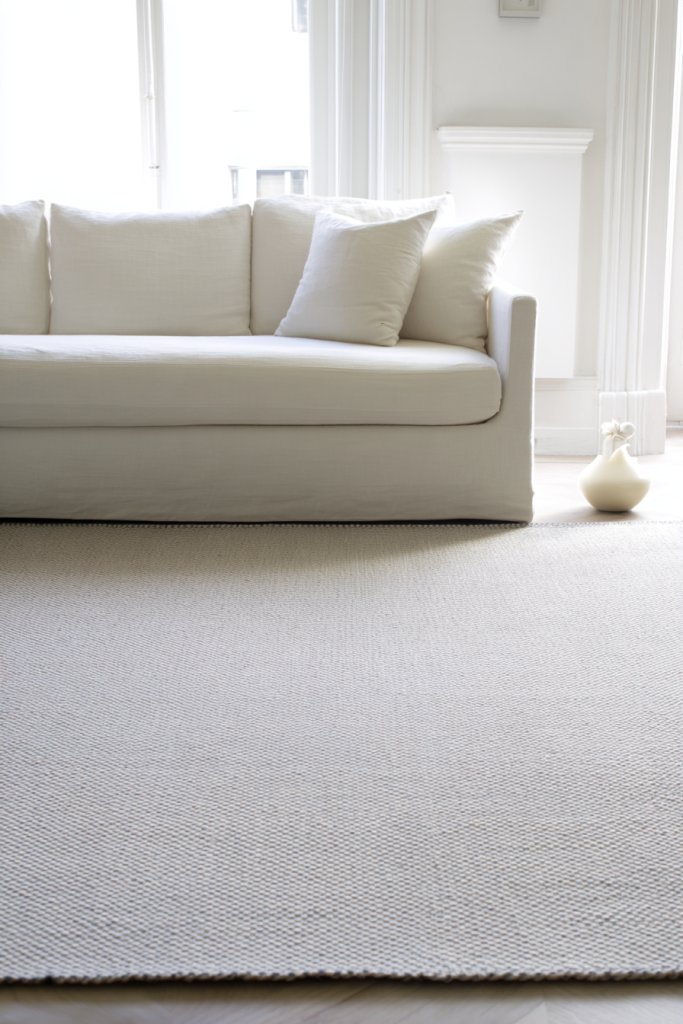
Overdecorating can make even the most beautiful room feel crowded. Maintaining open space helps your decor breathe and prevents visual overload. It’s about choosing quality over quantity and allowing each piece to stand out. Less clutter equals more calm.
Picture a room with only a few carefully selected pieces—perhaps a low sofa, a textured rug, and a sculptural chair. Surfaces are kept clear, with only essential items displayed. Negative space emphasizes the simplicity and elegance of each element. Natural light floods the room, highlighting the clean lines and open layout.
Use empty walls or large windows to create a sense of expansiveness. Limit decorative objects on surfaces to a few meaningful items. In small rooms, prioritize vertical storage or wall-mounted features to free up floor space. For seasonal decor, swap out accessories without cluttering surfaces.
Choose furniture with simple, sleek designs that don’t overwhelm the space. Keep surfaces tidy by using hidden storage or decorative boxes. Regularly declutter by removing non-essential items—be ruthless. Use a neutral color palette to unify the space and avoid visual noise. Maintain a balance between emptiness and functionality.
Add a single statement piece—a sculptural lamp, a textured throw, or a unique chair—that draws attention without clutter. Incorporate textured textiles or subtle patterns for depth. Use large, simple artwork or mirrors to visually expand the space. Keep the overall aesthetic calm and cohesive.
Open, uncluttered spaces promote mental clarity and calmness. They also make cleaning easier and less time-consuming. When your home feels spacious and orderly, it boosts your mood and inspires a more mindful lifestyle.
13. Incorporate Japanese-Inspired Shoji Screens or Sliding Doors
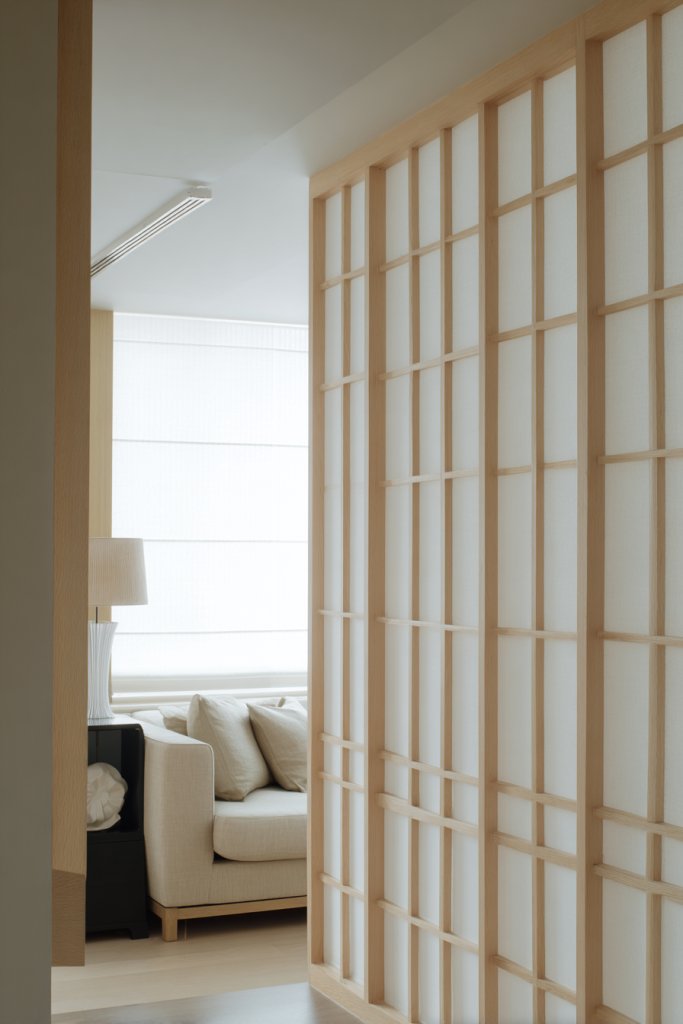
Want to subtly partition your space without sacrificing flow? Shoji screens and sliding doors offer a perfect blend of privacy and openness. They add a touch of Japanese elegance and simplicity, enhancing your minimalist aesthetic. Plus, they’re highly functional and space-saving.
Imagine lightweight, wooden-framed shoji screens with translucent paper panels, sliding smoothly to reveal or conceal areas. They soften the room’s lines and introduce a delicate, textured element. The screens’ neutral tones blend seamlessly with the overall decor, creating a harmonious, zen-inspired environment. When open, they expand the space; when closed, they create intimate zones.
Choose sliding doors with natural wood finishes or painted in muted shades. Incorporate them into existing walls or as room dividers. For a more modern twist, opt for minimalist metal frames with frosted glass. They work well in small apartments or open-plan layouts, providing flexibility with style.
Install tracks and hardware that are simple yet durable. Ensure the doors slide smoothly and are easy to operate. Maintain the panels with gentle cleaning to preserve translucency. Use them to separate sleeping areas, workspaces, or to hide storage. Keep the surrounding decor minimal to highlight their elegance.
Customize with different panel materials—such as textured rice paper or frosted glass—for varied visual effects. Add subtle hardware or handles that match your overall style. Pair with other Japanese-inspired details like tatami mats or wooden flooring for a cohesive look. Keep the space uncluttered around the screens.
Shoji screens and sliding doors add both function and beauty, elevating your space effortlessly. They reflect a mindful approach to design, emphasizing simplicity and natural materials. When installed thoughtfully, they transform your home into a tranquil, harmonious retreat.
14. Select Simple, Elegant Tableware and Decorative Objects
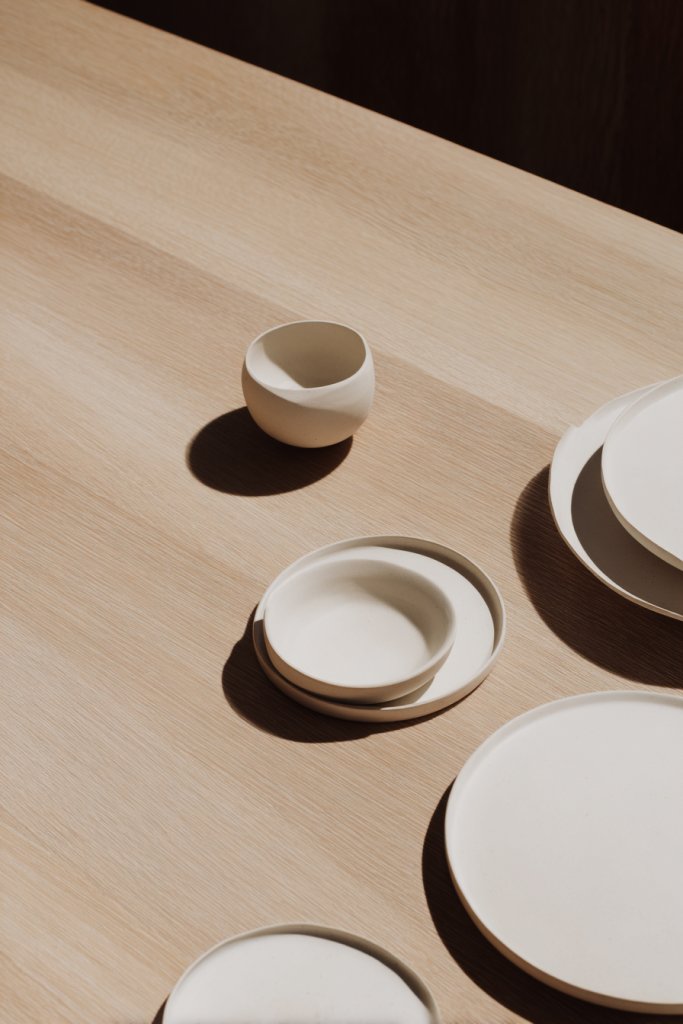
Tired of cluttered surfaces filled with mismatched dishes and trinkets? Simple, elegant tableware and decor elevate your space while keeping it uncluttered. It’s about choosing quality pieces that serve both function and style. Less is more when it comes to a peaceful, minimalist aesthetic.
Picture a sleek wooden tray holding a few handcrafted ceramic bowls in neutral tones. The table is free of excess, with only a few tasteful objects—perhaps a textured vase or a sculptural candle holder. The overall look is understated and refined, emphasizing craftsmanship and simplicity. The arrangement invites calm and mindful use.
Opt for matte or glazed ceramics in subdued shades—taupe, grey, or off-white. Limit decorative objects to a few meaningful pieces, avoiding clutter. For seasonal variations, swap out textiles or add a subtle pop of color with accessories like a silk cloth or a textured placemat. Keep the styling clean and intentional.
Choose tableware made from natural materials—ceramic, wood, or stone—that complement your overall palette. Use uniform styles for a cohesive look or mix textures for visual interest. Store items in minimal, well-organized cabinets or open shelves. Maintain their appearance through gentle cleaning and careful handling.
Incorporate handcrafted or artisanal pieces that reflect your personality. Personalize your tableware with subtle patterns or textures, and pair them with simple textiles. Add a few carefully selected decorative objects in neutral tones to enhance the aesthetic without cluttering.
Choosing simple, elegant tableware elevates everyday routines and makes hosting more mindful. It encourages appreciation of craftsmanship and quality over quantity. When your table setting is thoughtfully curated, it enhances your home’s overall sense of calm and sophistication.
15. Use Black or Dark Accent Elements for Contrast and Depth
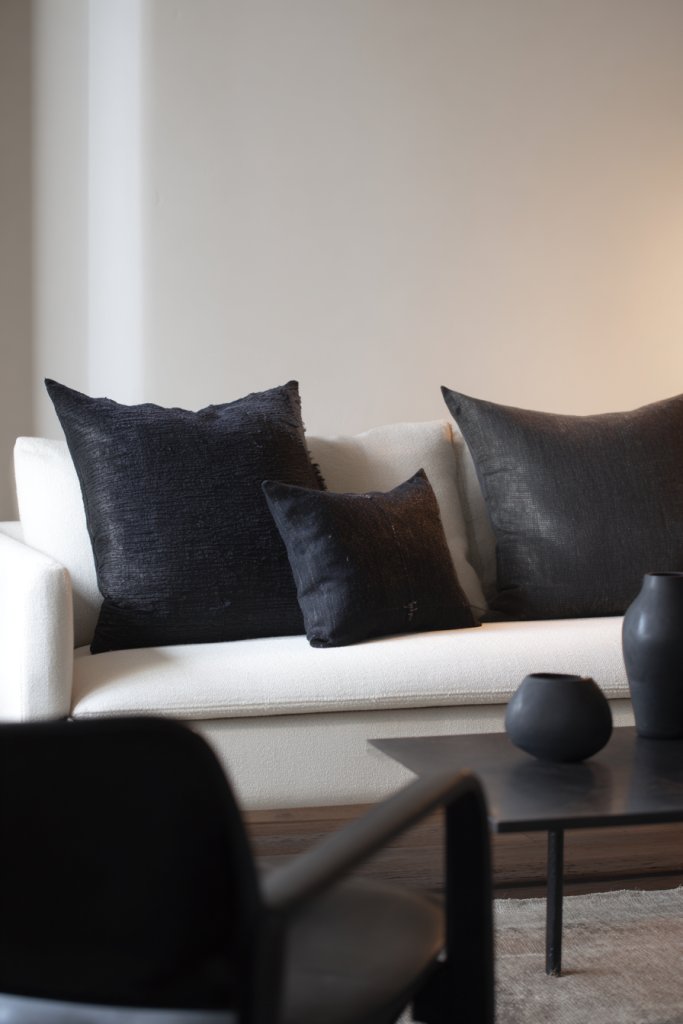
Feeling like your space lacks depth or visual interest? Dark accents—like black or deep charcoal—add contrast that grounds a minimalist palette. They create striking focal points without overwhelming the serenity. This simple trick can dramatically elevate your decor game.
Imagine a matte black picture frame on a neutral wall or a dark metal coffee table in the center of a light-toned room. The contrast draws your eye and adds sophistication, while the rest of the decor remains soft and muted. Small accent pieces like picture frames, hardware, or decorative objects in dark hues punctuate the space, adding depth and drama.
Incorporate black or dark elements in furniture legs, hardware, or light fixtures for subtle contrast. Use dark accent walls or panels to create visual anchors. For a softer look, pair dark accents with warm wood tones or textured textiles. Seasonal changes can include adding dark cushions or throws for a cozy touch.
Choose matte or brushed finishes for a modern, understated look. Use dark hardware on cabinets or doors to create a cohesive design language. Balance the dark accents with plenty of light and neutral surroundings to prevent the space from feeling heavy. Use small, impactful pieces to keep the overall aesthetic balanced.
Personalize with decorative objects like black ceramic bowls, picture frames, or sculptural accessories. Mix materials—matte metals, dark ceramics, and wood—to add richness. Incorporate these accents thoughtfully, focusing on areas where they can serve as visual anchors or focal points.
Dark accents add sophistication and dimension that transform a simple space into something more curated. When used with restraint, they enhance the overall aesthetic without overpowering the calm vibe. This approach makes your home look intentionally designed and effortlessly stylish.
16. Integrate a Cozy Reading Nook with a Low-Profile Chair and Side Table

Want a dedicated corner for relaxation without cluttering your main living area? A cozy reading nook with a low-profile chair creates a peaceful retreat. It’s a perfect spot to unwind, reflect, or enjoy a good book. Plus, it adds personality to your space without sacrificing minimalism.
Picture a low, cushioned chair in a neutral fabric, paired with a simple side table made of wood or stone. The space is defined by a textured rug and layered textiles like a throw blanket or cushion. Soft lighting from a wall sconce or hidden LED strips creates a warm, inviting glow. The setup encourages calm and quiet moments.
Choose a chair with a simple silhouette—think Scandinavian or mid-century modern styles. Add a small, functional side table that complements the chair’s material and color. Personalize with a textured throw or cushion in muted hues. For small spaces, position the nook near a window or in a corner to maximize space.
Select comfortable, low-profile seating that fits your style—think upholstered or wooden frames. Use a textured rug to define the area visually. Incorporate layered textiles for warmth and softness. Use warm, dimmable lighting for ambiance. Keep the surrounding area decluttered to preserve the peaceful vibe.
Personalize the space with a favorite book, a decorative tray, or a handcrafted cushion. Add a small bookshelf or wall-mounted shelves nearby for easy access. Incorporate natural details like stone or wood accents to enhance the organic feel. Keep the decor simple to maintain tranquility.
A well-designed reading nook invites you to slow down and enjoy quiet moments. It adds a layer of comfort and personality without cluttering your main living space. When you create intentional corners for relaxation, your home feels more welcoming and balanced.
17. Incorporate Subtle Metallic Accents in Lighting or Hardware
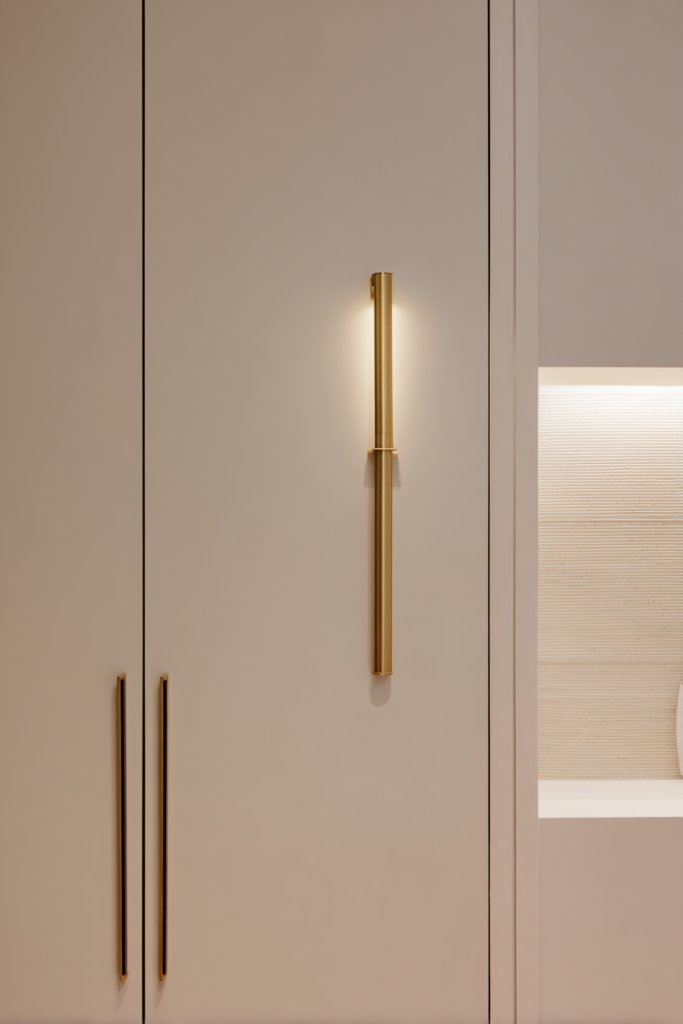
Looking to add a touch of modern sophistication without overwhelming your minimalist aesthetic? Subtle metallic accents in lighting fixtures or hardware can do just that. They provide a refined contrast that elevates your decor with minimal effort. Plus, they’re versatile enough to suit various styles.
Imagine matte black or brushed bronze cabinet handles, complemented by matching fixtures. These small details catch the light and add depth to your design. The metallic finishes contrast beautifully with neutral walls and organic textures, creating a cohesive, understated elegance. It’s all about the details that make a big impact.
Choose fixtures with sleek, geometric shapes—like round or rectangular designs—in matte or brushed finishes. Use metallic accents on door handles, drawer pulls, or light switch plates. Mix different metals subtly—like bronze with matte black—for layered visual interest. Seasonal updates can include swapping hardware or fixtures for different finishes.
Select hardware and fixtures that feature subtle metallic finishes—avoid overly shiny or ornate designs. Install fixtures carefully, ensuring proper placement and safety. Coordinate hardware across furniture, cabinetry, and lighting for a unified look. Keep surfaces clean and free of fingerprints to preserve the finish. Regular maintenance keeps the metallic accents looking fresh.
Personalize with handcrafted or artisanal fixtures to add uniqueness. Use metallic accents to highlight architectural details or to frame artwork and mirrors. Incorporate textured or matte finishes to add depth and reduce glare. Balance metallic elements with natural textures for a balanced, elegant aesthetic.
Subtle metallic accents elevate your decor with a refined, contemporary touch. They reflect light beautifully, adding brightness without clutter. When used thoughtfully, these details help create a cohesive, polished environment that feels both modern and timeless.
18. Create Visual Balance with Symmetrical Arrangements
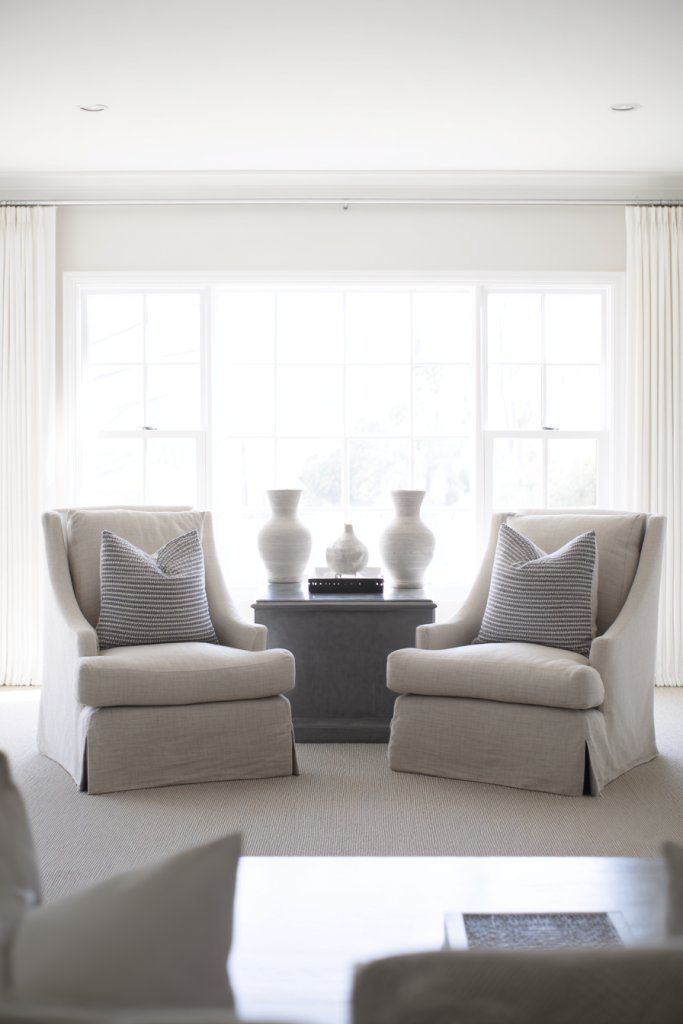
Feeling off-balance or chaotic in your decor? Symmetry provides a sense of harmony and order that’s visually soothing. It’s a simple technique to make your living space feel more polished and intentional. Plus, it helps you arrange decor with confidence.
Picture a pair of matching armchairs flanking a low coffee table, with identical cushions and side tables. The artwork or decor on either side mirrors each other, creating a balanced focal point. Neutral tones and aligned furniture lines reinforce the sense of symmetry. The overall effect is calming and well-curated.
Use symmetry in furniture placement, lighting, and accessories—think matching lamps or identical vases. For asymmetrical spaces, balance larger elements with smaller, offset objects. In larger rooms, mirror architectural features or window placements to create harmony. Seasonal decor can also follow symmetrical patterns for consistency.
Plan your layout with balance in mind: position furniture and decor so that visual weight is evenly distributed. Use identical or similar objects on each side of a focal point. Maintain consistent spacing and alignment to reinforce symmetry. Keep clutter minimal to prevent imbalance. Regularly reassess the arrangement to ensure it remains harmonious.
Personalize with meaningful objects arranged symmetrically—such as framed photos or decorative sculptures. Incorporate textured textiles or layered rugs that complement the overall balance. Use lighting to highlight symmetry, like matching sconces or pendants. Keep the decor simple but thoughtfully arranged.
Symmetrical arrangements foster a sense of stability and calm in your home. They make your decor feel intentional and effortlessly stylish. When your space feels balanced, it naturally promotes relaxation and mental clarity, turning your home into a sanctuary.
19. Add a Small, Purposeful Indoor Plant for a Touch of Nature (Using Faux if Restricted)
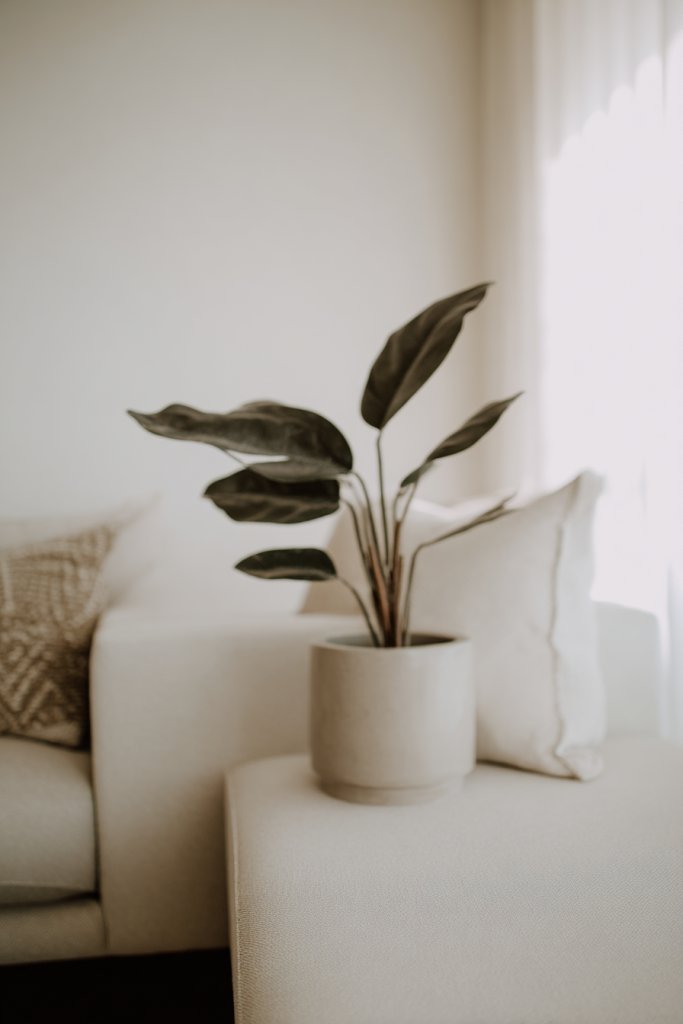
Craving a breath of fresh air in your home? A small, purposeful plant can bring a touch of nature inside without overwhelming your minimalist aesthetic. If real plants are off-limits, high-quality faux options can still add life and texture. It’s a quick way to boost your space’s vitality.
Imagine a simple ceramic pot holding a faux succulent or a high-quality faux fern placed on a shelf or side table. The greenery adds a pop of color and organic texture against neutral backgrounds. The plant’s presence softens hard lines and introduces a calming element. When styled thoughtfully, it looks natural and complements your decor.
Select small plants that fit your space—think succulents, air plants, or small ferns. Use minimal, modern planters in neutral or textured finishes. Change or rotate faux plants seasonally for variety, or add a real plant if possible. Pair with other natural textures like wood or stone for a cohesive look.
Choose high-quality faux plants with realistic foliage. Position them in spots with good light—near windows or under soft lighting. Keep them clean and dust-free to maintain realism. Use simple planters that match your overall aesthetic—ceramic, concrete, or bamboo. Avoid overstuffing surfaces; less is more.
Create small plant arrangements with different textures and heights for visual interest. Incorporate decorative stones or minimalistic containers. Use the plants to frame key areas or focal points within your room. Combine faux with real plants in other parts for a dynamic, natural feel.
A small plant, real or faux, instantly adds vibrancy and a sense of life to your home. It’s an easy, low-maintenance way to connect with nature and boost your mood. When styled intentionally, even tiny touches of greenery can transform your space into a peaceful retreat.
20. Use Textured Wall Finishes like Clay or Stucco in Soft Tones
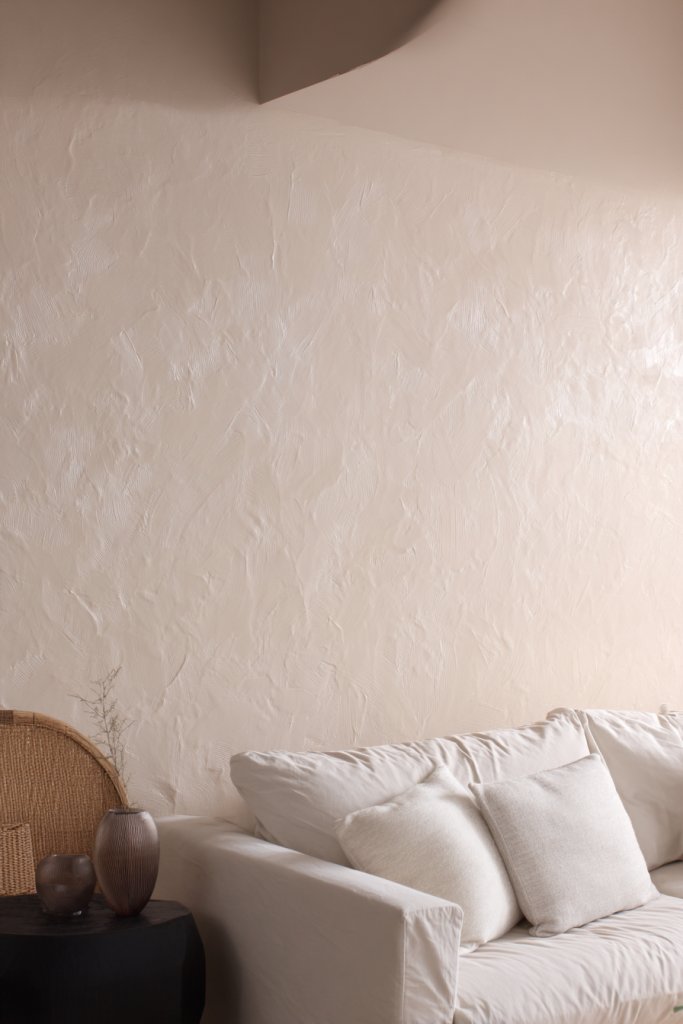
Tired of flat, uninspiring walls? Textured finishes like clay or stucco add depth and character without cluttering the space. They create a tactile backdrop that enhances your minimalist decor. It’s an easy way to introduce subtle visual interest.
Imagine a wall coated in soft, matte stucco with a slightly uneven surface, painted in a gentle neutral shade. The texture catches light differently throughout the day, adding dimension. Complement this with simple furniture and textiles to let the wall’s character shine. The overall effect is warm, inviting, and refined.
Choose subtle textures like a smooth troweled finish or more pronounced patterns such as gentle ridges or stippling. Use these finishes on accent walls or entire rooms, depending on your space. Pair with minimal decor to avoid visual overload. Seasonal accents can include textured textiles or lighting to highlight the wall’s surface.
Work with a skilled plasterer or DIY with textured paints and tools. Prepare your wall surface properly, ensuring it’s clean and smooth before applying finishes. Use natural, muted colors for a calming effect. Finish with a matte or low-sheen topcoat to enhance the texture. Regular maintenance involves gentle cleaning to preserve the surface.
Highlight textured walls with directional lighting or wall washers. Incorporate artwork or decor that complements the tactile surface—think minimal sculptures or textiles. Use color accents sparingly to maintain the soft, understated aesthetic. Personal touches like handcrafted wall finishes add uniqueness.
Textured finishes create a rich, layered environment that feels both modern and timeless. They evoke craftsmanship and natural beauty, elevating your decor subtly. When your walls have depth and character, your entire space feels more curated and inspiring.
21. Incorporate Layered Lighting for Mood and Functionality
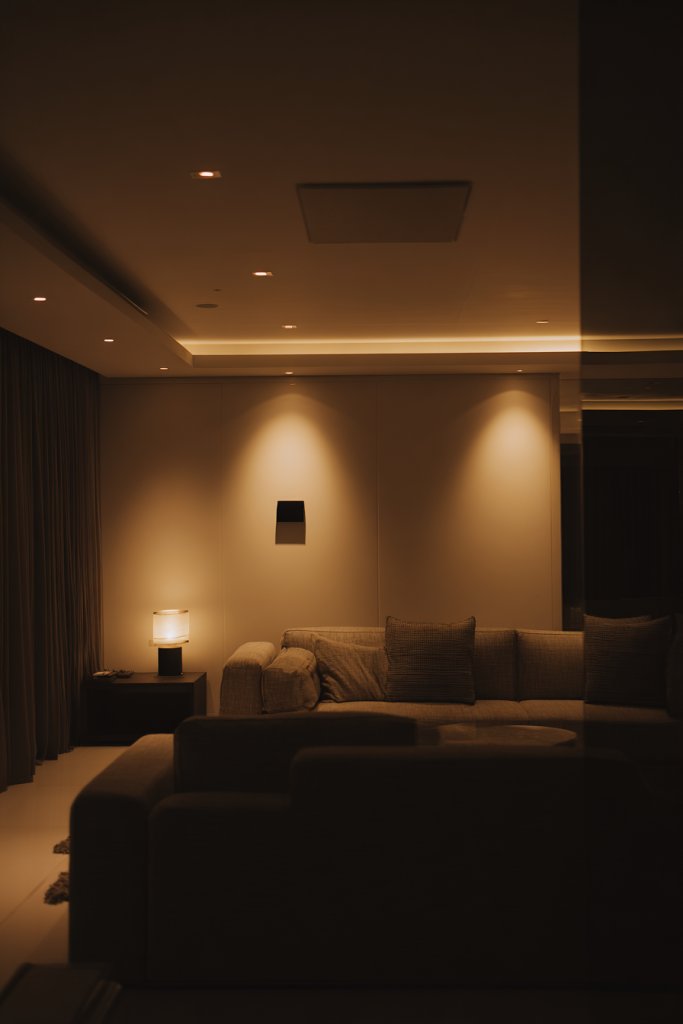
Does your space lack warmth or flexibility? Layered lighting allows you to create different moods and functions with ease. By combining ambient, task, and accent lighting, you can tailor your environment to any activity. It’s an effective way to make your home more versatile and inviting.
Imagine a room with soft ambient light from concealed LED strips, focused task lighting over a reading nook, and subtle accent lighting highlighting architectural features. The layers work together to produce a balanced, welcoming glow. Dimming controls let you adjust brightness to suit your mood, from bright and energetic to calm and cozy.
Use warm white bulbs for a cozy feel, or cooler tones for a modern vibe. Incorporate wall sconces, recessed fixtures, or hidden lighting to keep surfaces uncluttered. In smaller spaces, focus on indirect lighting to avoid harsh shadows. Seasonally, you can swap out bulbs or add portable lamps for variety.
Plan your lighting layout carefully, ensuring each layer complements the others. Install dimmers and smart controls for flexibility. Use fixtures with simple, minimalist designs that blend into your decor. Keep wiring tidy and hidden to preserve the clean aesthetic. Regularly check and replace bulbs to maintain consistent lighting quality.
Personalize by adding decorative fixtures like pendant lights or sculptural sconces that serve as focal points. Use textured lampshades or diffusers to soften light further. Incorporate lighting that highlights specific decor elements or architectural details. Keep the overall design cohesive and understated.
Layered lighting transforms your home into a dynamic space that adapts to your needs and mood. It enhances the aesthetic without clutter, creating a relaxing environment. When your lighting is flexible and intentional, your home becomes a true sanctuary of calm and style.
22. Decorate with Minimalist, Handcrafted Art Pieces in Neutral Colors

Want art that elevates your decor without overwhelming it? Minimalist, handcrafted pieces in neutral colors add sophistication and personality. They create focal points that complement your serene aesthetic. Plus, they’re timeless and easy to integrate into any space.
Imagine a small, handcrafted ceramic sculpture on a sleek shelf or a simple, textured wall hanging in muted tones. The art’s subtle presence enhances the room’s calm atmosphere while adding a layer of depth. The craftsmanship shines through in the details, inviting closer inspection. It’s about quality over quantity.
Choose pieces with natural textures—clay, wood, or woven fibers—that align with your decor palette. Mix sizes and shapes for visual interest, but keep the color scheme neutral. Rotate art seasonally or for special occasions to maintain freshness. Keep display surfaces uncluttered to highlight each piece.
Select artisanal or handmade pieces that resonate with your style—think simple ceramics, carved wood, or woven textiles. Display them on floating shelves, minimalist pedestals, or within simple frames. Use lighting to accentuate textures and craftsmanship. Maintain the art by gentle cleaning and careful handling.
Incorporate personal or cultural artifacts that tell your story. Pair art with textured textiles or organic materials for layered interest. Keep arrangements balanced and uncluttered, allowing each piece to breathe. Personal touches make your decor more meaningful.
Handcrafted art pieces add authenticity and a sense of soul to your decor. When curated thoughtfully, they elevate your environment and reflect your personal taste. A curated collection of minimalist, artisanal art fosters a space of calm and inspiration.
Conclusion
This collection of Japandi living room ideas showcases how to incorporate natural textures, minimalist furniture, and calming color schemes into your space. Each concept offers a unique way to achieve that perfect balance of simplicity and elegance. Don’t hesitate to try these ideas and personalize them to suit your home — your serene sanctuary awaits. Embrace the Japandi lifestyle and create a living room that nurtures your mind and soul.